Count the number of Keys in a Dictionary in Python
Last updated: Apr 8, 2024
Reading time·4 min

# Count the number of Keys in a Dictionary in Python
Use the len() function to count the number of keys in a dictionary, e.g.
result = len(my_dict).
The len() function can be passed a collection such as a dictionary and will
return the number of key-value pairs in the dictionary.
my_dict = { 'name': 'Bobby Hadz', 'age': 30, 'tasks': ['dev', 'test'] } result_1 = len(my_dict) print(result_1) # 👉️ 3 result_2 = len(my_dict.keys()) print(result_2) # 👉️ 3
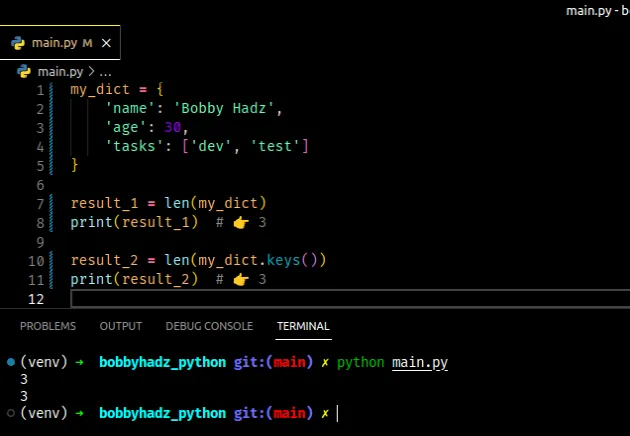
The len() function returns the length (the number of items) of an object.
The first example shows how to get the number of key-value pairs in the dictionary.
my_dict = { 'name': 'Bobby Hadz', 'age': 30, 'tasks': ['dev', 'test'] } result_1 = len(my_dict) print(result_1) # 👉️ 3
len() function is sufficient.# Explicitly using the dict.keys() method
The dict.keys() method returns a new view of the dictionary's keys.
my_dict = {'id': 1, 'name': 'Bobby Hadz'} print(my_dict.keys()) # 👉️ dict_keys(['id', 'name']) print(len(my_dict.keys())) # 👉️ 2
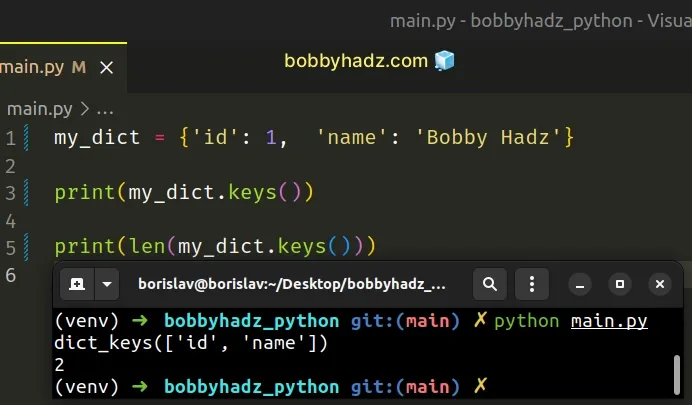
You can use the list() class if you need to convert the view of keys into a list.
my_dict = {'id': 1, 'name': 'Bobby Hadz'} list_of_keys = list(my_dict.keys()) print(list_of_keys) # 👉️ ['id', 'name'] print(len(list_of_keys)) # 👉️ 2
Note that passing the dictionary directly to the len() function is a little
faster than creating a view object via the dict.keys() method and passing the
view to the len() function.
# Using a for loop to count the number of keys in a dictionary
You can also use a for loop to count the number of keys in a dictionary.
my_dict = { 'name': 'Bobby Hadz', 'age': 30, 'tasks': ['dev', 'test'] } count = 0 for key, value in my_dict.items(): count += 1 print(key, value) print(count) # 👉️ 3
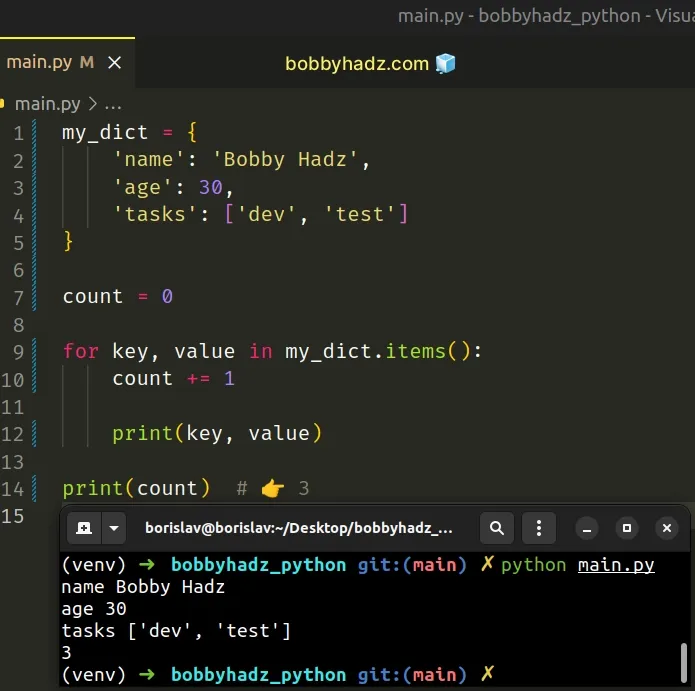
We used a for loop to iterate over the dictionary's items and on each
iteration, we increment the count variable.
The dict.items() method returns a new view of the dictionary's items ((key, value) pairs).
my_dict = {'id': 1, 'name': 'BobbyHadz'} # 👇️ dict_items([('id', 1), ('name', 'BobbyHadz')]) print(my_dict.items())
If you don't need to access the key and value while iterating, iterate over the dictionary directly.
my_dict = { 'name': 'Bobby Hadz', 'age': 30, 'tasks': ['dev', 'test'] } count = 0 for key in my_dict: count += 1 print(key) print(count) # 👉️ 3
On each iteration, we get access to the key in the for loop and increment the
value of the count variable.
# Count the number of dictionary keys with values matching condition
You can also use a for loop if you need to count the number of dictionary keys
with a particular value.
my_dict = { 'a': 1, 'b': 10, 'c': 30, } count = 0 for key, value in my_dict.items(): if value > 5: count += 1 print(key, value) print(count) # 👉️ 2
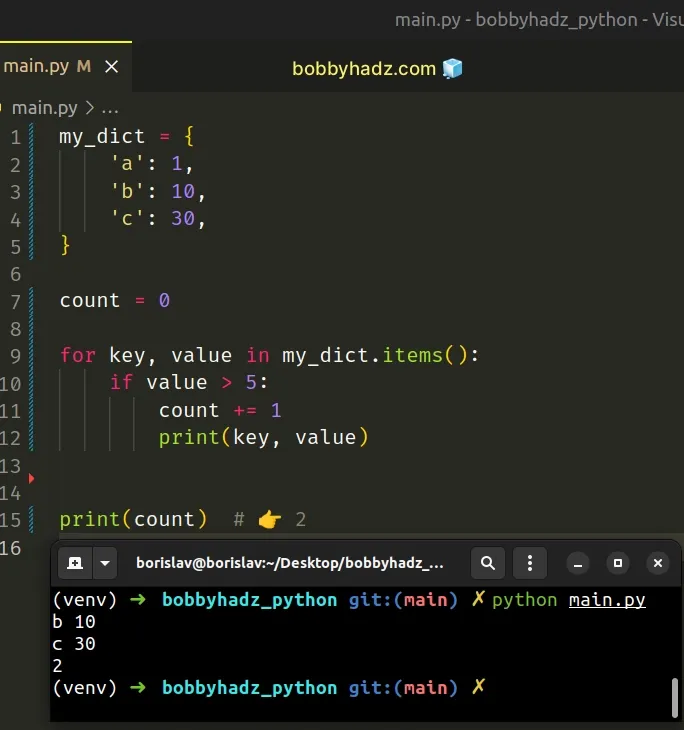
We used a for loop to iterate over the dictionary's items.
On each iteration, we check if the current value is greater than 5.
If the condition is met, we increment the count.
The dictionary has 2 keys that have values greater than 5, so the count
variable stores a value of 2 after the last iteration.
# Checking if the dictionary is empty
You can also use the len() function to check if a dictionary is empty.
my_dict = {} if len(my_dict) == 0: # 👇️ This runs print('dict is empty') else: print('dict is not empty')
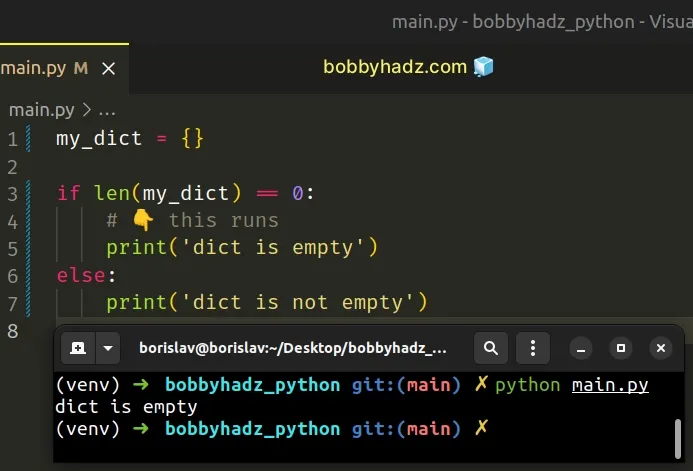
If a dictionary has a length of 0, then it's empty.
You might also see examples online that check whether the dictionary is truthy (to check if it contains at least 1 key-value pair), which is more implicit.
my_dict = {} if my_dict: print('dict is NOT empty') else: # 👇️ This runs print('dict is empty')
All values that are not truthy are considered falsy. The falsy values in Python are:
- constants defined to be falsy:
NoneandFalse. 0(zero) of any numeric type- empty sequences and collections:
""(empty string),()(empty tuple),[](empty list),{}(empty dictionary),set()(empty set),range(0)(empty range).
Notice that an empty dictionary is a falsy value, so if the dict is empty, the
else block is run.
If you need to check if the dictionary is empty using this approach, you would
negate the condition with not.
my_dict = {} if not my_dict: # 👇️ This runs print('dict is empty') else: print('dict is NOT empty')
# Additional Resources
You can learn more about the related topics by checking out the following tutorials:

